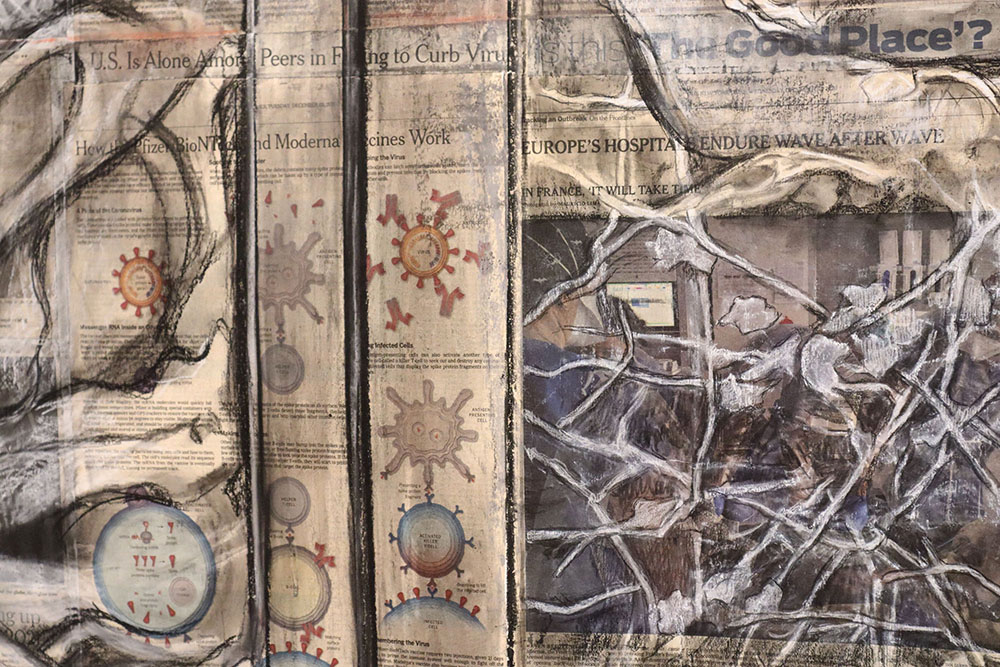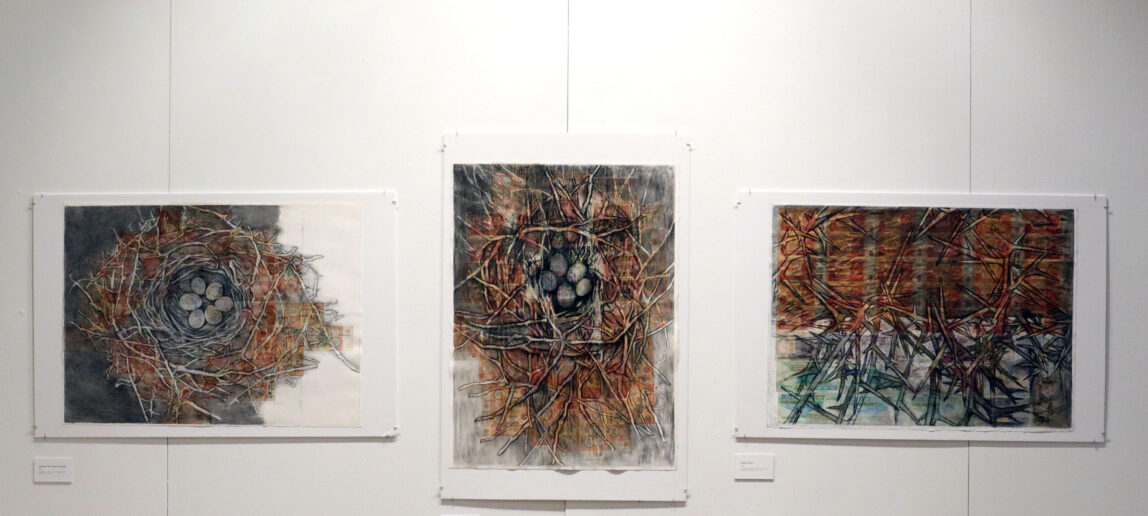‘Lamentations’ Exhibition By Lydia Bodnar-Balahutrak To Close April 25 At Wright Gallery
Ukrainian-American artist Lydia Bodnar-Balahutrak’s works will be on display through April 25 at Wright Gallery in the Langford Architecture Center, Building A.
Hosted by the Texas A&M College of Performance, Visualization and Fine Arts and the School of Architecture, the exhibition titled “Lamentations” features work of mixed-media collages that address current events.
Bodnar-Balahutrak was born in Cleveland, Ohio, and is based in Houston. Her grandparents on both sides of her family are of Ukrainian descent, and she said they had a definitive impact on her formative years and on her art. Her art “probes cultural ties and collective memory, and explores defining moments in history and our place in it,” she said.
“Like many others in the United States, I have grown up in two cultures,” she said during her recent discussion at Wright Gallery. “The hereditary culture passed on and nurtured by my displaced, post-World War II refugee family from Ukraine; and the culture of the United States, which is the country I was born in and raised and continue to live and work.”
Bodnar-Balahutrak said her family was an early subject of her drawings and paintings. After her first trip to Ukraine in 1991, she said it was a pitvotal moment.
“This trip opened my eyes and soul to a long-suffering yet hopeful people, to a land beautiful but ravaged by the Soviet system,” she said. “And it was a turning point in my work and my worldview.”
Bodnar-Balahutrak was also a Fulbright U.S. Scholar fellow in Poland in 2022-23, and said she “experienced the horrors of war through the eyes of Ukrainian refugees there.”
“Lamentations” showcases collages of print media documenting cultural, social and political issues including Russia’s invasion of Ukraine and the COVID-19 pandemic. Drawn on top of each piece are depictions of nature and words of poetry that were inspired by her 1995 trip to the Chernobyl exclusion zone.
The work begins by collecting news articles and cultural artifacts that address historic current events, she said. She arranges them in a “self-perpetuating dialogue,” and then collages them on canvas or paper, she said.
“Imagery evolves by adding and subtracting elements of found text, and by painting and drawing, combining oil, charcoal, chalks and wax,” she said. “At the same time, I am examining the nature of print media, how information is revealed and what is concealed. I see how narratives can be created, implied, hidden, disguised.”

A three-part collage titled “Pandemic Lamentations,” is part of the exhibition, accompanied by documentation with an essay by art historian Anna Tahinci. The works began as a form of “commemoration and catharsis,” she said. The process started with drawing on large expanses of paper, up to 24 feet wide, unrolled and pinned to her studio wall, she said. Pandemic news stories from The New York Times and Houston Chronicle were used throughout the collage.
Karen Hillier, Wright Gallery Curatorial Committee member and professor emerita, said Bodnar-Balahutrak’s work has a “virtuosic hand” as it “lures the viewer” into her art.
“Once engaged, the viewer becomes entangled in the tragic realities of living that drive the artist to speak: the horrors of the pandemic or the turmoil of Ukraine’s history and current state of war,” Hillier said. “Throughout her imagery, fragments of nature frame the work. The viewer apprehends her meanings looking through densities of vines, branches, leafiness and grass. The artist reminds us that nature is supreme in providing hope and solace — like in the nest drawings — and in reclaiming the mess of mankind.”

